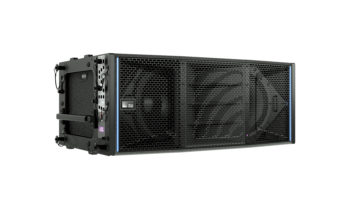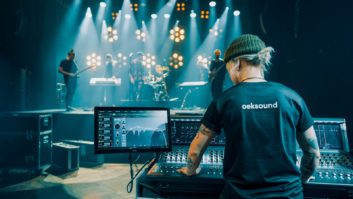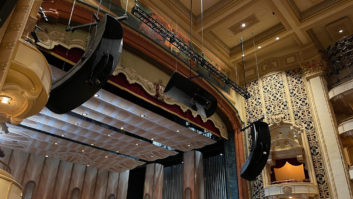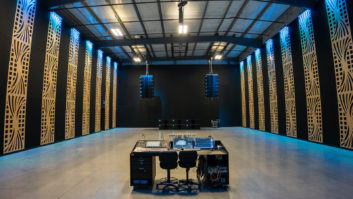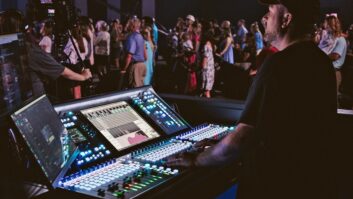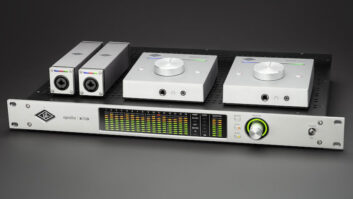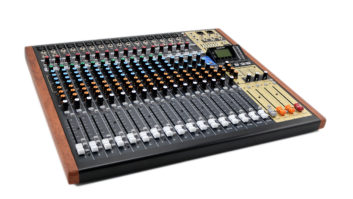STUDIO PRODUCTS
DPA 4560 CORE Binaural Headset Microphone

YouTubers, sound designers, podcasters, vloggers and other content creators, including filmmakers who want to capture authentic immersive audio for their projects, can now do so thanks to the launch of the new 4560 CORE binaural headset microphone from DPA Microphones.
At the heart of DPA’s new 4560 CORE binaural headset is a pair of 4060 CORE miniature microphones mounted on two ear hooks and sitting just outside the user’s ear canal (like a pair of earbuds). This makes it possible to directly capture (1:1) the sound heard by the person making the recording. The ear hooks are attached to a flexible headset that is simple to fit, comfortable to wear and easily adjusted to suit the dimensions of each individual head. Foam screens are supplied with the microphones to secure their position and offer damping of wind noise.
In addition to being worn, the 4560s can attach to recording gear, like DPA’s MMA-A digital audio interface, that connects to any iOS-devices. This gives users a mobile binaural recording solution for any setting.
Drawmer 1970 Dual FET Compressor and Preamp

Drawmer has expanded its compression offerings with the new Drawmer 1970 Dual FET compressor and preamp. Engineers will notice the similarity of the 1970’s layout to the company’s 1960 mic pre and vacuum tube compressor, and it is destined to fit a similar role in applications where transparent preamps and punchy FET compression fit the bill.
Like the 1960, the Drawmer 1970 features two channels of preamplification and compression that can operate independently or in true stereo-link mode. The 66 dB preamps are built around the latest THAT Corporation technology. In addition to phantom power, the preamps offer matched impedance for unpowered microphones at 200, 600, and 2400 ohms. Like the 1960, the 1970 offers an instrument-level direct input with gain, boost, and newly-engineered bass and treble adjustments. Users select from among the mic preamps, line-level inputs and instrument-level input as the sources for the compressors, with phase-reverse and a high-pass filter. The compressor section includes fine control over threshold, ratio, attack and release, and the 1970 incorporates “BIG” and “AIR” processing to enhance deep lows and sparkling highs, respectively. The output section includes wet/dry mix, make-up gain, bypass and a pair of analog VU meters.
Moog Vocoder Returns

After more than 40 years, Moog Music has resumed production of the highly sought-after Moog 16 Channel Vocoder. The Moog 16 Channel Vocoder is crafted with care by the employee-owners at Moog Music in Asheville, North Carolina. The instrument works by continuously analyzing the timbral characteristics of one sound (program) and impresses these timbral characteristics upon a second signal (carrier).
The Moog 16 Channel Vocoder offers 16 patchable bands ranging from 50 to 5080 Hz for optimal encoding of the fundamental spectral characteristics of the human voice. In addition, a selectable DIRECT mode passes an additional high frequency channel (above 5080 Hz) to the Vocoder output for a greater degree of vocal intelligibility. While traditionally associated with vocal effects, the Moog 16 Channel Vocoder’s ultra-fast response time makes it additionally useful for capturing the fast transients of percussive sounds.
RØDE NT-USB Mini

The RØDE Microphones NTUSB Mini is a compact USB microphone that offers studio-quality recording direct to a computer or tablet. Featuring a high-quality condenser capsule with RF shielding and capsule isolation, it delivers professional-sounding audio in any application, from recording vocals and instruments, to podcasting and voiceovers, to gaming and live streaming.
A built-in pop filter reduces plosives and its pickup pattern has been optimized to reduce extraneous noise like room reverberation, air conditioning and traffic, and focus on what’s in front of it. The NT-USB features a class-compliant USB output for direct recording to a computer or tablet. No drivers or software are needed, and no external power required to operate, just plug in and hit record. It works with any recording software or streaming app, and studio-quality 24-bit, 48 KHz A/D conversion ensures extremely low distortion and very high dynamic range.
The NT-USB Mini features a studio-grade headphone amplifier and a high-quality 3.5mm headphone output, complete with precision volume control. There is also a switchable zero-latency monitoring mode for eliminating distracting echo when tracking vocals or recording instruments.
Mackie Element Series Microphones

Mackie has launched its new EleMent Series microphones, consisting of three models: the EM-89D live vocal dynamic, EM-91C large-diaphragm condenser and EMUSB USB condenser microphones.
The EM-89D dynamic microphone features a cardioid polar pattern and is primarily designed for stage use, but can double in the studio. Similarly, while it’s intended to be a handheld vocal microphone, it can also be used as an instrument and amplifier microphone. The EM-89D comes with a mic clip, XLR mic cable, and zipper pouch.
The new Mackie EM-91C’s classic cardioid polar pattern makes it flexible enough to handle a variety of studio applications. While Mackie recommends using it on stringed instruments, the microphone is also up for live streaming, voiceovers and other types of content creation. The EM-91C comes with a shock mount and an XLR mic cable.
The Mackie EM-USB condenser microphone connects directly to a laptop or mobile recording device using USB-C and features a built-in headphone output with independent volume control. It also provides controls for main input gain and mute. Included with the EM-USB are a mic clip, tripod mount, and USB-C cable.
Available in February, the EM-89D carries a US MAP of $69.99; the EM-91C is priced at $79.99 US MAP; and the EM-USB is available at $149.99 US MAP.
NUGEN Audio Unveils SEQ-S Software Update

NUGEN Audio has announced the latest software release for its SEQ-S linear phase “spline match and morph” EQ solution. Now with a resizeable direct-draw interface and EQ matching presets, SEQ-S is designed to make it easy for producers to fine-tune audio.
SEQ-S’s visual interface adapts to suit the task at hand, whether simple or sophisticated. Using this solution, producers can fine-tune their tracks with flexible, detailed envelopes. The new preset system for EQ matching enables producers to expedite their workflow by streamlining the match EQ process. Additionally, the system’s newly implemented resizeable interface offers further flexibility for users to set up SEQ-S for their precise workflow needs, allowing for more detailed curve sculpting, among other things.
With three independent curves that are individually assignable across the surround panorama, SEQ-S gives users complete control over a spatial environment. SEQ-S is capable of automated fluid filer morphs, which enables producers to provide everything from controlled scene transitions to full-blown creative sound sculpting. Additionally, the control functionality of the SEQ-S software provides access to mid-side, 5.1 and 7.1 surround operation; node locking; zoom-able views; flexible curve assignment; dynamic EQ; sonic fingerprinting; and psycho-acoustic banding options. The three independent EQ transition pairs include dynamic and static pass filter effects; seamless transitions between environments; and creative morphs and tempo-locked effects.
SOUND REINFORCEMENT PRODUCTS
Meyer Sound ULTRA-X20 Loudspeaker and USW-112P Subwoofer

The new Meyer Sound ULTRA-X20 compact point source loudspeaker is a junior-sized version of the ULTRA-X40 loudspeaker, and offers the same design principles and technologies, but employs smaller drivers in a lighter and more compact package.
The ULTRA-X20 incorporates two 5-inch cone drivers, one 2-inch diaphragm compression driver and a rotatable 110- x 50-degree horn in a coaxial configuration. Power comes from a 3-channel Class D amplifier with DSP, with everything placed inside a compact cabinet that measures 7.5 inches wide by 19.04 inches high by 8.6 inches deep and weighs 26 pounds. Preliminary performance specifications give an operating frequency range of 60 Hz to 18 kHz, phase response of ±45 degrees (100 Hz – 16 kHz) and linear peak SPL of 123.5 dB measured with M-Noise.
The USW-112P compact subwoofer packs low frequency performance into a slender, self-powered package measuring less than 12 inches deep. The slanted connector panel allows placement flush to walls, in vertical or horizontal orientation. The USW-112P houses a single 12-inch long-excursion driver along with a Class D amplifier and digital signal processing. The cabinet design features a low velocity port, based on the USW-210P, with optimized tuning for linear response and low distortion. Preliminary performance specifications include a linear peak output (measured with M-Noise signal) of 123 dB SPL across an operating frequency range of 35 Hz to 140 Hz. Phase response measures ±30 degrees from 45 Hz to 120 Hz.
DiGiCo A164D Wall LCD and A168D Stage for 4REA4

DiGiCo has announced two new I/O Racks—the A164D Wall LCD and A168D Stage—for its 4REA4 processing engine for networked audio in installations. Both Racks bring all the connectivity of the original A164 Wall LCD and A168 Stage, but with the additional advantage of Dante connectivity.
The A164D Wall LCD is a 16-input, four-output I/O expander that uses the Dante network protocol to provide fixed additional I/O anywhere on a network and is designed for wall or floor mounting. It comes with 16 mic preamps on XLR inputs with phantom power status LEDs and four XLR line outs with direct preamp control from the 4REA4 controller software. It can run at both 48K and 96k sample rates and is AES67 compatible. Primary and secondary Dante ports come with locking EtherCON connectors and can run in both redundant and switched mode. All LCD labels are dimmable and can be customized using Dante controller software.
The A168D Stage is a portable 16-input, eight-output I/O expander, again using the Dante network protocol to provide additional I/O anywhere on a network. It comes with 16 mic preamps on XLR inputs with phantom power status LEDs and eight XLR line outputs with direct preamp control from the 4REA4 controller software. It runs at 48k and 96k and is AES67 compatible. Primary and secondary ports again come with locking EtherCON connectors and can run in redundant or switched mode.
d&b audiotechnik KSLi System

The new d&b audiotechnik KSLi System, based around KSLi8 and KSLi12 loudspeakers, KSLi-SUB and KSLi-GSUB, and a new 40D installation amplifier, is intended to provide systems integrators with a complete installation package.
Key to the d&b audiotechnik KSLi System are the KSLi8 and KSLi12, which the company states are acoustically identical to the mobile KSL System, providing 80- and 120-degree horizontal dispersion, respectively, with pattern control aided by the geometry of two front-facing 10-inch drivers and two side firing 8-inch drivers, which couple and apply cardioid techniques to cause directivity with low-frequency headroom.
The new KSLi SUB, meanwhile, can be flown in an array (KSLi-SUB) or ground stacked (KSLi-GSUB).
The 40D installation amplifier is designed for fixed installation applications and is the most powerful 4-channel Class-D installation amplifier in the d&b range. The new 40D amplifier also features a 4.3-inch color display showing a range of speaker settings, device status and more.
DiGiCo Quantum338 Console

The new DiGiCo Quantum338 digital mixing system is based around seventh-generation FPGAs and includes 128 input channels with 64 busses and a 24 x 24 matrix, all with full channel processing. A “dark mode” is available, to be used on the desk’s three 17-inch, 1000-nit high-brightness multi-touch screens, allowing both the meter bridge and soft quick select buttons to be displayed on each screen.
There are also 70 individual TFT channel displays, and the floating Quantum chassis features 38 x 100mm touch-sensitive faders laid out in three blocks of 12 fader banks, along with two dedicated user-assignable faders, each complete with high resolution metering. The desk offers 32-bit ADC and DAC converters, which are built into Quantum338 as standard, alongside six single or three redundant MADI connections, dual DMI slots and a built-in UB MADI USB recording interface.
